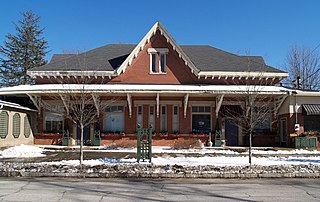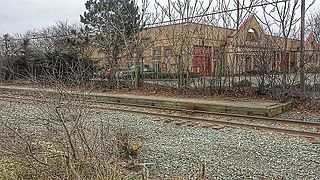
The MBTA Commuter Rail system serves as the commuter rail arm of the Massachusetts Bay Transportation Authority's (MBTA's) transportation coverage of Greater Boston in the United States. Trains run over 394 mi (634 km) of track to 134 stations. It is operated under contract by Keolis, which took over operations on July 1, 2014, from the Massachusetts Bay Commuter Railroad Company (MBCR).

The Old Colony Railroad (OC) was a major railroad system, mainly covering southeastern Massachusetts and parts of Rhode Island, which operated from 1845 to 1893. Old Colony trains ran from Boston to points such as Plymouth, Fall River, New Bedford, Newport, Providence, Fitchburg, Lowell and Cape Cod. For many years the Old Colony Railroad Company also operated steamboat and ferry lines, including those of the Fall River Line with express train service from Boston to its wharf in Fall River where passengers boarded luxury liners to New York City. The company also briefly operated a railroad line on Martha's Vineyard, as well as the freight-only Union Freight Railroad in Boston. The OC was named after the "Old Colony", the nickname for the Plymouth Colony.

The Boston and Providence Railroad was a railroad company in the states of Massachusetts and Rhode Island which connected its namesake cities. It opened in two sections in 1834 and 1835 - one of the first rail lines in the United States - with a more direct route into Providence built in 1847. Branches were built to Dedham in 1834, Stoughton in 1845, and North Attleboro in 1871. It was acquired by the Old Colony Railroad in 1888, which in turn was leased by the New Haven Railroad in 1893. The line became the New Haven's primary mainline to Boston; it was realigned in Boston in 1899 during the construction of South Station, and in Pawtucket and Central Falls in 1916 for grade crossing elimination.

Braintree station is an intermodal transit station in Braintree, Massachusetts. It serves the MBTA's Red Line and the MBTA Commuter Rail Old Colony Lines as well as MBTA buses.

The Providence/Stoughton Line is an MBTA Commuter Rail service in Massachusetts and Rhode Island, primarily serving the southwestern suburbs of Boston. Most service runs entirely on the Northeast Corridor between South Station in Boston and Providence station or Wickford Junction station in Rhode Island, while the Stoughton Branch splits at Canton Junction and terminates at Stoughton. It is the longest MBTA Commuter Rail line, and the only one that operates outside Massachusetts. The line is the busiest on the MBTA Commuter Rail system, with 17,648 daily boardings in an October 2022 count.

The Middleboro Secondary is a railroad line owned by MassDOT in the U.S. state of Massachusetts. The line runs from Attleboro to Middleborough via Taunton.

Mansfield station is an MBTA Commuter Rail station in Mansfield, Massachusetts. Located in downtown Mansfield, it serves the Providence/Stoughton Line. With 1,966 weekday boardings in a 2018 count, Mansfield is the third-busiest station on the system outside Boston.

Canton Center is an MBTA Commuter Rail station in Canton, Massachusetts. It serves the Providence/Stoughton Line, including most Stoughton Branch service except for evening inbound trains. The station has 1 side platform on the south side of the track west of Washington Street; the platform has a mini-high section for accessibility.

Holbrook/Randolph station is an MBTA Commuter Rail station on the border of Holbrook and Randolph, Massachusetts. It is served by the Middleborough/Lakeville Line.

Middleborough/Lakeville station is an MBTA Commuter Rail station in Lakeville, Massachusetts, just south of the Middleborough border. It is the southern terminus of the Middleborough/Lakeville Line; it is also an intermediate stop for seasonal CapeFlyer service to Cape Cod. Middleborough/Lakeville has a single full-length high-level side platform serving the line's single track.

Old Colony Railroad Station is an historic Italianate train station located off Dean Street in Taunton, Massachusetts. The historic station, also known as Dean Street, is proposed to be joined by the modern Taunton station around 2030 as part of Phase 2 of the South Coast Rail project.

South Coast Rail is a project to build a new southern line of the MBTA Commuter Rail system along several abandoned and freight-only rail lines. The line has been planned to restore passenger rail service between Boston and the cities of Taunton, Fall River, and New Bedford, via the towns of Berkley, and Freetown, on the south coast of Massachusetts. It would restore passenger service to some of the southern lines of the former Old Colony Railroad and the New York, New Haven and Hartford Railroad.

Raynham Place station is a proposed MBTA Commuter Rail station in Raynham, Massachusetts. Under current plans, it would be constructed behind the Raynham Park racing center north of downtown Raynham and open in 2030 as part of the second phase of the South Coast Rail project.

East Taunton station is an under-construction MBTA Commuter Rail station in East Taunton, Massachusetts adjacent to the interchange between the Route 24 expressway and County Street. It is planned to open in mid-2024 as part of the first phase of the South Coast Rail project.

Freetown station is a future MBTA Commuter Rail station located in the Assonet village of Freetown, Massachusetts. It is planned to open in mid-2024 as part of the first phase of the South Coast Rail project. The station will have a single side platform on the west side of the Fall River Secondary, along with a park and ride lot.

Fall River station is an under-construction MBTA Commuter Rail station in Fall River, Massachusetts. The station is being constructed as part of the South Coast Rail project and is expected to open in mid-2024.

Taunton station was a passenger rail station located south of Oak Street in downtown Taunton, Massachusetts. As Taunton Central station, it served local and Boston-focused routes from 1836 to 1964. A later station at the same site served Amtrak's Cape Codder from 1986 to 1996, and Cape Cod and Hyannis Railroad commuter trains in 1988.

Middleborough station is an under-construction MBTA Commuter Rail station in Middleborough, Massachusetts. It is expected to open in mid-2024 as part of the South Coast Rail project, replacing Middleborough/Lakeville station for regular service. The station will have a single side platform located inside the wye between the Middleborough Main Line and the Middleboro Secondary.

The Old Colony Street Railway Company was a horse-drawn and electric streetcar railroad operated on the streets of Boston, Massachusetts and communities south of the city. Founded in 1881 as the Brockton Street Railway Company, via lease and merger it became a primary mass transit provider for southeastern Massachusetts and Rhode Island. Its immediate successor was the Bay State Street Railway, and its modern successor is the state-run Massachusetts Bay Transportation Authority (MBTA).

The Whittenton Branch was a short railroad branch in the state of Massachusetts that formerly connected the city of Taunton and Raynham. The 3-mile branch initially opened in 1881 and was later extended to connect the New Bedford and Taunton Railroad and the Dighton and Somerset Railroad.





















